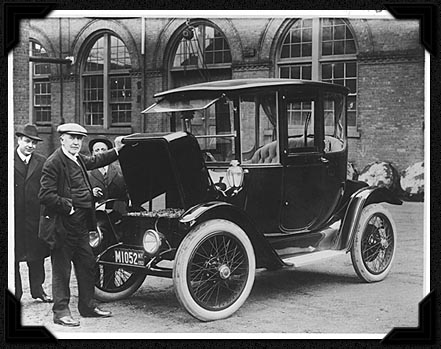By Paul Vachon

1914 image of Edison with the early electric car
Every time a fascinating technological innovation makes its appearance, our media driven culture develops a new vocabulary around it. For example, products introduced to have little environmental impact were labeled “eco-friendly” or “green.” The recent introduction of electric vehicles such as the Chevrolet Volt and Nissan Leaf, represent a radical break from cars with the internal combustion engine – and may make us think of the EV as something brand new. The concept, however, dates to the earliest years of the auto industry.
These manufactures took their cue from early experiments in electric locomotion done in Great Britain and Germany during the late nineteenth century. Inventor Thomas Parker in England first electrified the London Underground in 1890.
Improvements in battery technology soon allowed the concept to be applied to the “horseless carriage” in the burgeoning American auto industry. Names both familiar and obscure (Columbia, Studebaker, Edison and Detroit Electric) turned out electric models ideally suited for urban travel, a use that made their disadvantages less tolerable. These included a top speed of 20 mph and severe limits on range. However, freedom from the noise, smell and difficulty in starting associated with gasoline powered cars proved to be attractive, especially to female drivers.
By the 1920s, driving distances grew as newly built highways and longer range gasoline powered cars appeared. Demand for (and the cost effectiveness of) electric vehicles faded as a result.
Concerns over the environment and energy resources forced the discussion of electric vehicles beginning in the 1970s, but powerful American oil interests and the slow pace of battery technology prevented the introduction of modern versions until recently.
About the author: Paul Vachon is a freelancer in Detroit who writes on local history, religion, education and occasionally politics.
